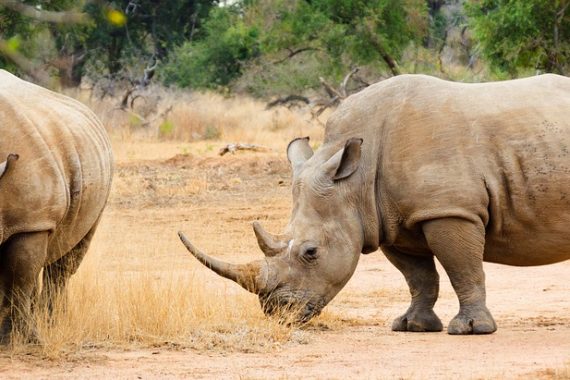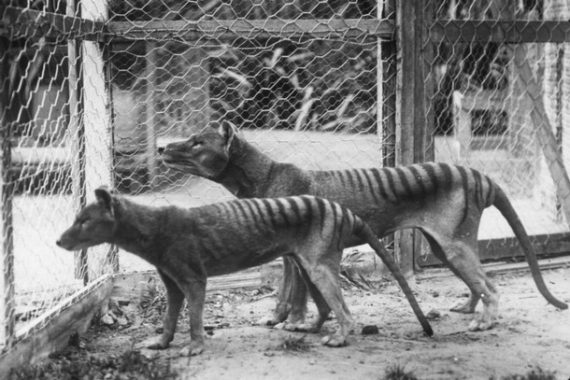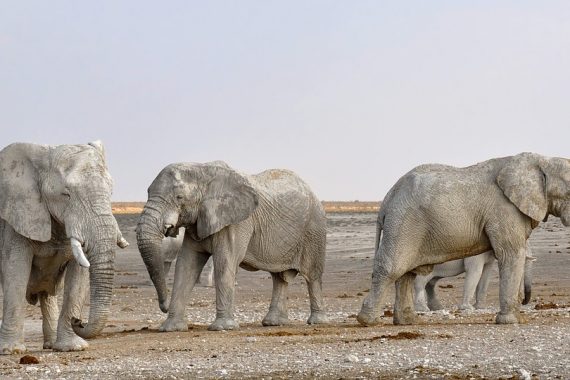Pygmy Hippopotamus (Choreopsis liberiensis)
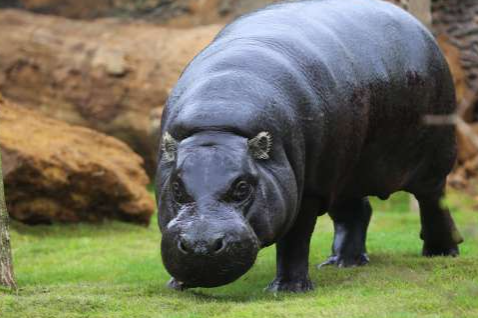
Far shyer and harder to find than their larger cousins, pygmy hippos are endemic only to West Africa, where their numbers are falling. Discovered in 1849, they were initially put into the hexaprotodon genus alongside the now extinct Indian and Southeast Asian hippos, until further studies put them in the Hippopotomidae, alongside their larger relative, the common hippo (Hippopotamus amphibius). Although it may not seem like it, the closest relative to hippos are whales, or the cetacean family, with a common ancestor living a semi amphibious existence 50-60 million years ago. This ancient ancestor became a genus called the anthracotheres that spread though Africa and Eurasia until they died out in the Miocene, likely due to climate change or competition with other mega-herbivores.
These roly-poly herbivores are not only popular with Western animal lovers, but also have an important cultural role in Africa. West African folklore tells tales of pygmy hippos that carry a diamond in their mouth that can light their way through the dense forest at night. During the day, they hide the diamond away in a secret place, but if a hunter can follow the pygmy hippo and catch it during the night, they can find the jewel and steal it away.
A small hippo with a small range: habitat under threat
There are two subspecies of the pygmy hippo, determined by cranial morphology, Choreopsis liberiensis liberiensis, found across West Africa in Guinea, Liberia, Sierra Leone and the Ivory Coast. The other subspecies Choreopsis liberiensis heslopi is only found in the Niger Delta in Nigeria, although there have been no official reports since 1945, sparking fears this subspecies has gone extinct.
More solitary than the common hippo, these chubby herbivores spend most of their time close to water, grazing on leaves, herbs aquatic plants and fallen fruit. They have a specially evolved four chambered stomach toWhen moving about the forest, they follow game trails forged by other animals through the thick undergrowth. Mostly nocturnal or crepuscular and notoriously shy, very little is known about their behaviour and reproduction in the wild, although the zoo populations have provided some insights.
The pygmy hippo, like so many other endangered species, once had a much larger range, that has significantly shrunk over the last 50 years as human pressures increase. Now, the populations that are left are severely fragmented by the destruction of their lowland forest habitat. Liberia is at the heart of the species range, in no small part due to the huge tracts of undisturbed humid forests and swamps that exist there. There are much smaller populations in other areas of their range, which are at a much higher risk of local extinction.
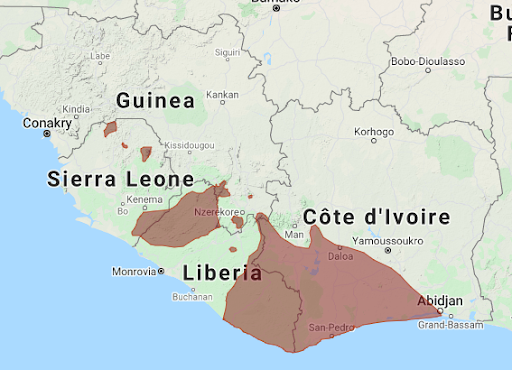
Habitat loss and fragmentation is arguably the biggest threat facing pygmy hippos in the wild today. Farming, logging, mining, and increasing human settlements have driven the remaining individuals into small pockets and there is now virtually no untouched forest left in West Africa. Only 15% of New Guinea’s forest are protected under the law, and in Liberia and Sierra Leone only a tiny 2% of forested land is under some form of legal protection. Political and military disruption in Sierra Leone, Guinea and the Ivory Coast has left the species even more vulnerable, with only 2000 estimated to be left. Although not commonly hunted by poachers, there has been some demand for their teeth and bones, and in particular, social conflict in West Africa has driven desperate people to turn to the bushmeat trade, either for income or food. With habitats shrinking more and more each year, hunting is becoming far more accessible to people with even the most basic wilderness skills.
But fortunately, pygmy hippo conservation is on the radar of the world’s conservationists. The Zoological Society of London have listed the pygmy hippo on their EDGE species list, a global initiative that works to save the worlds most evolutionarily distinct and endangered species. ZSL first got involved in 1993, when it was determined that numbers have fallen as low as 2000. In collaboration with Fauna and Flora International, another conservation organisation, ZSL worked with the Forestry Development Authority in Liberia to carry out surveys and ecological and behavioural research to determine where the pygmy hippos were found and what threats they faced. In 2010, they held the first Conservation Planning Workshop, which has shaped the conservation strategies in place today. They have also been heavily involved in engaging local stakeholders, training park officials and educating African students to become the future stewards of the species and their habitat.
Although there is so little protected land in West Africa, the hippos have largely retreated into what few protected areas there are in the region. Research conducted into land usage and the geo-political state of the area has made it clear that currently, extending the protected areas to allow more space for the hippos is not an option. Instead, the authors of the paper concluded that involving local communities through education and providing better economic outcomes has a much higher chance of success.
The species has legal protection, being listed on appendix two of CITES, meaning any trade in hippo hunting and parts is tightly controlled. However, disruption and social conflict in West Africa makes it difficult for this to be regulated in any way, and in any case hunting is not the biggest threat facing pygmy hippos, but rather land use change and habitat loss, arguably a much bigger issue to tackle.
In the case that field conservation completely fails, pygmy hippos are part of a captive breeding programme, which has also been invaluable for providing important behavioural and physiological research that was impossible to carry out in the field, due to the shy nature of the hippos.
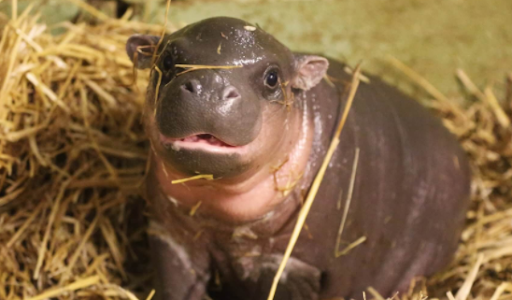
Possibly one of the cutest baby animals in existence: this roly poly little guy was born at ZSL in 2014 to mum Flora, and is a vital part of the breeding programme.
Conservation organisations and heroes!
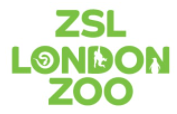
The Zoological Society of London
- ZSL have arguably been one of the leaders in pygmy hippo conservation, setting up a captive breeding programme and authoring the conservation strategy that is still in use today. They also placed hippos on their EDGE of Extinction programme
- You can donate to ZSL to support their pygmy hippo conservation programmes, and their other projects all over the world. You can also visit the zoo and their exhibition of their two pygmy hippos, Thug and Nicky. Don’t be fooled by the name; Thug is a pretty soft guy!
Awesome videos!
References
Boisserie, J.R. (2003) ‘The phylogeny and taxonomy of Hippopotamidae: a review based on morphology and cladistic analysis.’ Zoological Journal of the Linnean Society, 143, pp 1-26
Conway, A.L. Hernandez, S.M. Carroll, J.P. Green, C.T. and Larson, L.R. (2014) ‘Local awareness of and attitudes towards pygmy hippopotamus conservation in the Moa River Island Complex, Sierra Leone.’ Oryx, 49(3)
Geisler, J.H. and Uhen, M.D. (2003) ‘Morphological support for a close relationship between hippos and whales.’ Journal of Vertebrate Paleontology, 23(4), pp 991-996
Hillers, A. Buchanan, G.M. Garteh, J.C. Tommy, S.M. Fofana, M.L. and Lindsell, J.A. (2016) ‘A mix of community-based conservation and protected forest is needed for the survival of the endangered pygmy hippopotamus Choreopsis liberiensis.’ Oryx, 51(2)
http://www.edgeofexistence.org/species/pygmy-hippopotamus/
https://www.iucnredlist.org/species/10032/18567171
https://www.zsl.org/zsl-london-zoo/exhibits/pygmy-hippos
Ursing, B.M. and Arnason, U. (1998) ‘Analyses of mitochondrial genomes strongly support a hippopotamus whale clade.’ Proc Biol Sci, 265(1412), pp 2251-2255


